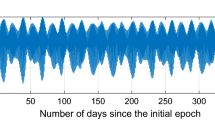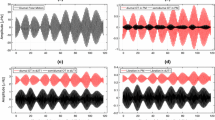Abstract
The large ring laser gyroscope at the Geodetic Observatory Wettzell provides unique data of the rotational component of seismic waves. Wind has been identified as a major source of noise at short periods below 5 min. Strong winds increase the level of detected background noise either through surface friction or through wind load on hill slopes. Since our G ring laser demonstrated a routinely achieved sensitivity for rotations of 10 picorad/s when averaged over 30 s, very small effects become detectable. Using a local finite element model and applying a digital terrain model with 25 m spatial resolution, the effect of local wind forces on tilt and horizontal rotations at the ring laser site was calculated. The transfer of forces by wind ram pressure or surface friction is strongly controlled by the resolution of the terrain model or the land use, respectively. The maximum deformation caused by real wind fields reaches a few tenths of nanorads for both tilt and horizontal rotation. While the tilts are too small to affect the ring laser measurements by a change in its inclination, the horizontal rotations can be detected by the ring laser if the signal builds up within a few seconds or tens of seconds. The comparison of the modelled rotation rate time series with measured ring laser data shows a reasonable agreement in amplitude and waveform, however the correction of the ring laser time series is limited by the crude sampling of the wind measurements.






Similar content being viewed by others
References
Abaqus Inc. (2007) ABAQUS documentation, version 6.7.
Altair Engineering, Inc. (2008) www.altair.com. Accessed 21 October 2008
Basis-DLM (2010) Digital LAND use Model 1:25000 Federal Agency of Cartography and Geodesy. http://www.geodatenzentrum.de. Accessed 1 May 2010
Batchelor GK (1967) An introduction to fluid dynamics. Cambridge University Press, New York
Donoho DL, Johnstone IM (1995) Adapting to unknown smoothness via wavelet shrinkage. J Am Stat Assoc 90(432):1200–1224
DTM-25 (2010) Digital Terrain Model 1:25000. Federal Agency of Cartography and Geodesy. http://www.geodatenzentrum.de. Accessed 1 May 2010
Emeis S, Zilitinkevich SS (1991) Resistance law, effective roughness length, and deviation angle over hilly terrain. Bound Lay Meteor 55(1–2):191–198
Emeis S (1987) Pressure drag and effective roughness length with neutral stratification. Bound Lay Meteor 39(4):379–401
Gebauer A (2009) The impact of topographic and geological features on deformations of the upper crust. Dissertation, Friedrich-Schiller-University Jena. http://www.db-thueringen.de/servlets/DocumentServlet?id=14899. Accessed 10 July 2011
Gebauer A, Steffen H, Kroner C, Jahr T (2010) Finite element modelling of atmosphere loading effects on strain, tilt and displacement at multi-sensor stations. GJI 181(3):1593–1612. doi:10.1111/j.1365-246X.2010.04549.x
Hadziioannou C, Gaebler P, Schreiber U, Wassermann J, Igel H (2012) Examining ambient noise using co-located measurements of rotational and translational motion. J Seismol (this issue)
Igel H, Nader M-F, Kurrle D, Ferreira AM, Wassermann J, Schreiber KU (2011) Observations of Earth's toroidal free oscillations with a rotation sensor: the 2011 magnitude 9.0 Tohoku-Oki earthquake. Geophys Res Lett. doi:10.1029/2011GL049045
Klügel T (2001) Analyse der Zeitreihen lokaler Rotationssensoren - Entwicklung eines Orientierungsmodells - Schlussbericht DFG-Forschungsprojekt ROT-SKOP (SCHN 240/6), 78, Wettzell, http://www.fs.wettzell.de/publ/publ/ROT-SKOP_schlussbericht.pdf. Accessed 20 July 2011
Klügel T (2002) Tilt variations at shallow depth: implications for the installation of a laser gyroscope at the Geodetic Observatory Wettzell. Bull d'Inf Marées Terr 137:10927–10930
Klügel T, Schreiber U, Schlüter, Velikoseltsev A (2008) Advances in inertial Earth rotation measurements—new data from the Wettzell G ring laser. Proceedings of the "Journées Systèmes de Référence Spatio-temporels 2007", Observatoire de Paris, 17-19 September 2007, eds. Nicole Capitaine, ISBN: 978-2-901057-59-8, 173-176.
Kroner C, Jahr T, Kuhlmann S, Fischer KD (2005) Pressure-induced noise on horizontal seismometer and strainmeter records evaluated by finite element modelling. GJI 161:167–178
Kümpel HJ (1982) Tilt measurements. What do they tell us? Terra Cognita 2:391–399
Rabbel W, Zschau J (1985) Static deformations and gravity changes at the earth’s surface due to atmospheric loading. J Geophys 56:81–99
Schreiber U, Klügel T, Stedman GE (2003) Earth tide and tilt detection by a ring laser gyroscope. J Geophys Res 108(B2):2132. doi:10.1029/2001JB000569
Schreiber KU, Velikoseltsev A, Rothacher M, Klügel T, Stedman GE, Wiltshire DL (2004) Direct measurement of diurnal polar motion by ring laser gyroscopes. JGR 109(B6):B06405
Schreiber U, Klügel T, Velikoseltsev A, Schlüter W, Stedman G, Wells JP (2009) The large ring laser G for continuous earth rotation monitoring. Pure Appl Geophys 166(8):1485–1498. doi:10.1007/s00024-004-0490-4
Schreiber U, Klügel T, Wells J-PR, Hurst RB, Gebauer A (2011) How to detect the chandler and the annual wobble of the earth with a large ring laser gyroscope. Phys Rev Lett 107(17):173904. doi:10.1103/PhysRevLett.107.173904
Shumway RH, Stoffer DS (2006) Time series analysis and its applications. Springer. ISBN: 978-0387293172
Spudich P, Steck LK, Hellweg M, Fletcher JB, Baker LM (1995) Transient stresses at Parkfield, California, produced by the M 7.4 Landers earthquake of June 28, 1992: observations from the UPSAR dense seismograph array. J Geophys Res 100(B1):675–690
Stedman GE (1997) Ring laser tests of fundamental physics and geophysics. Rep Prog Phys 60:615–688
Steffen H (2006) The importance of instrument location on barometric pressure-induced noise. Bull d'Inf Marées Terr 141:11293–11302
Suryanto WJ, Wassermann J, Igel H, Cochard A, Vollmer D, Scherbaum F, Velikoseltsev A, Schreiber U (2006) First comparison of seismic array derived rotations with direct ring laser measurements of rotational ground motion. Bull Seism Soc Am 96(6):2059–2071. doi:10.1785/0120060004
Velikoseltsev A,Schreiber U, Klügel, Voigt TS, Graham RD (2008) Sagnac Interferometry for the Determination of Rotations in Geodesy and Seismology, 15th St. Petersburg International Conference on Integrated Navigation Systems, St. Petersburg
Velikoseltsev A, Schreiber U, Klügel T (2009) Modelling of episodic-transient signals in measurements of large ring lasers. Final report of the DFG research project SCHR 645/2 (MOD-TRANS). Technical University Munich
Weise A (1992) Neigungsmessungen in der Geodynamik - Ergebnisse von der 3-Komponenten-Station Metsähovi. Technical University Clausthal, Dissertation
Zürn W, Exß J, Steffen H, Kroner C, Jahr T, Westerhaus M (2007) On reduction of long-period horizontal seismic noise using local barometric pressure. GJI 171(2):780–796. doi:10.1111/j.1365-246X.2007.03553.x
Acknowledgement
This study is funded by the German Research Foundation (DFG) under the Project SCHR 645/2-3 which is gratefully acknowledged.
Author information
Authors and Affiliations
Corresponding author
Additional information
This study is also found in the Proceedings to the 2nd International Working Group on Rotational Seismology (IWGoRS) workshop.
Rights and permissions
About this article
Cite this article
Gebauer, A., Schreiber, K.U., Klügel, T. et al. High-frequency noise caused by wind in large ring laser gyroscope data. J Seismol 16, 777–786 (2012). https://doi.org/10.1007/s10950-012-9283-x
Received:
Accepted:
Published:
Issue Date:
DOI: https://doi.org/10.1007/s10950-012-9283-x




